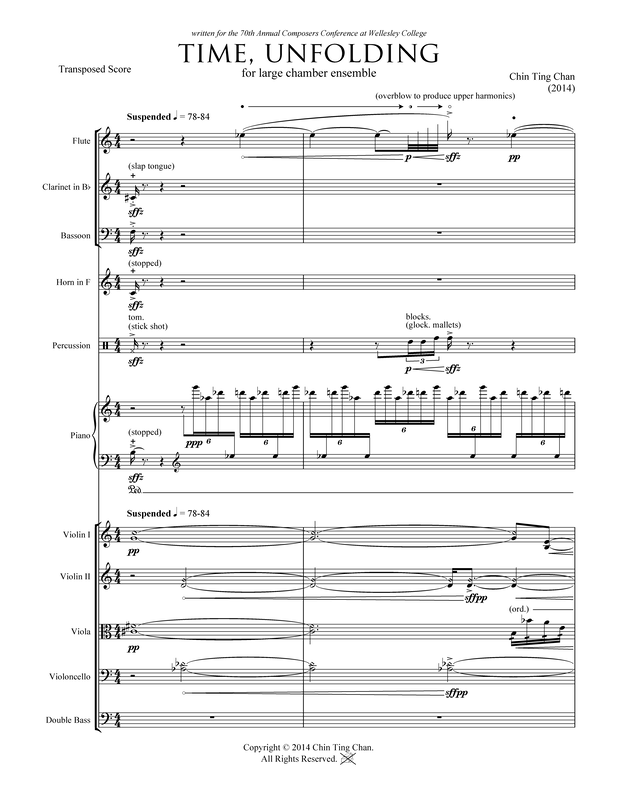time, unfolding for large chamber ensemble (2014)
time, unfolding was written for performance in the 70th Annual Composers Conference at Wellesley College. It explores the slow unfolding of musical materials and how it affects our perception of musical time. The idea of “unfolding time” manifests itself into the composition, and shapes the way it is structured in both the macro and micro levels. Ultimately, time is “unfolded” through the shape and movement that the music creates.
This piece features five sections, resembling a symmetrical arch form. The beginning section is built upon three twelve-note chords multi-layered with micro-rhythmic activities. It uses a gradual contraction of harmonic rhythm to progress. The pitches used are often register-specific, and they occasionally extend to the upper registers to create a richer timbre. In the next section, this static atmospheric sonority is dissolved. A linear progression that finds its root from the preceding section becomes the focus. This part projects the static harmony to the foreground, where it becomes more present, with contrapuntal activities and intricate rhythmic interplays between instruments.
The materials slowly migrate to a slower-paced passage that recalls the beginning texture. In this third section, the percussion and the piano resonate with the string harmonics and a mellow wind melody. A reverse process of materials soon follows. It allows the intricate activities to return, eventually building up to a final climax that has shimmering and brilliant textures, with the aid of aleatoric techniques. The work ends with the initial harmonic progression, combined with fragments of gestures from many previous sections.
The use of serial procedures is prominent in this composition. The pitch materials are entirely generated from a twelve-tone row that is stated in its original form for the first time in the second section. The row is often divided into sub-sets, which are used in combinations on different pitch levels by multiplication of either themselves or other sets. Additionally, the vertical sonority is controlled by intervallic relationships found within the tone row. Using these serial techniques allows me to create a homogeneous harmonic language throughout the work and to maintain control over the degree of atonality.
《時間‧伸展》於第70屆維斯里作曲家會議首演,作曲家嘗試以音樂素材各種的開展方式探討時間與聽覺的關係,並以此概念建構整首作品。 作品分成五大段,首段建基於三個由十二個音組成的和弦,它們在鬆緊拉扯之間制造張力,逐步把音樂推動至第二段,此時作品的旋律與節奏動機由不同的樂器呈現出來,樂器間緊密對應,此起彼落,形成活躍的多聲部織體,與先前成強烈對比,不過前段的素材亦不時重現,使兩段在對比之餘亦互為緊扣。 到了第三段,音樂仿似回到首段,但這次鋼琴與敲擊樂於背景以豐富的和聲配襯著弦樂與木管溫婉的旋律。此後,活潑的動機重現,線條再次彼此呼應,層層遞進,將音樂推至高潮,然後參差不齊的線條相繼消逝,最後以開首的和聲及一些樂句的重臨作結。
(07/25/2021)
* click here to return to Large Ensemble


